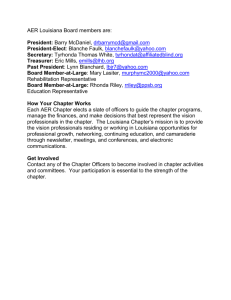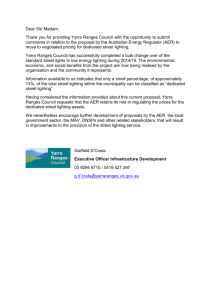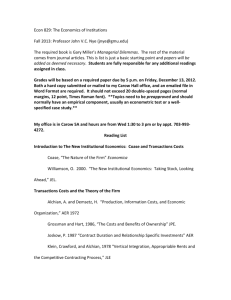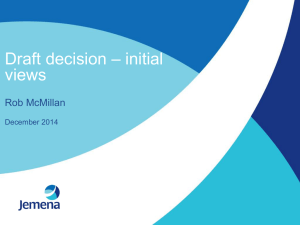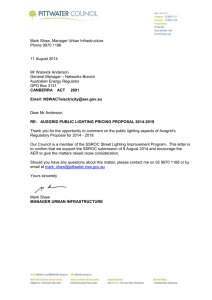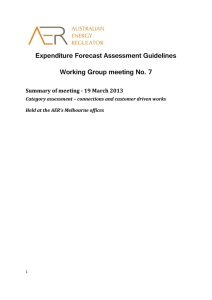Expenditure forecast assessment guideline
advertisement
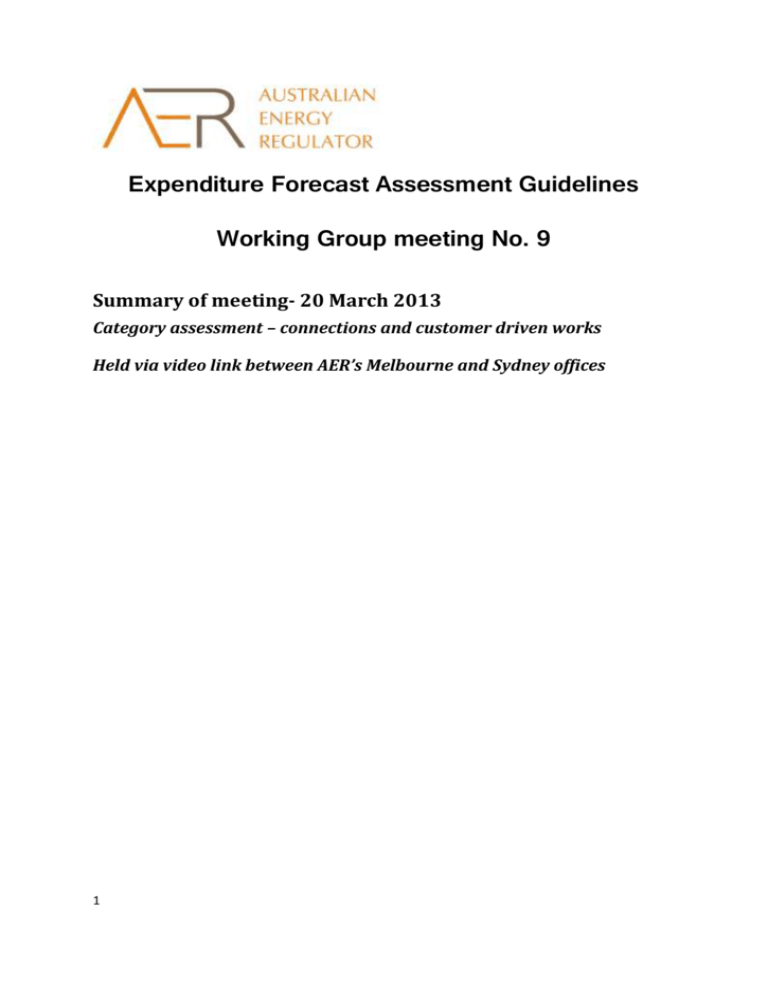
Expenditure Forecast Assessment Guidelines Working Group meeting No. 9 Summary of meeting- 20 March 2013 Category assessment – connections and customer driven works Held via video link between AER’s Melbourne and Sydney offices 1 On 20 March 2013, the AER, as part of its Better Regulation package, hosted a working group meeting on the development of the Expenditure forecast assessment guidelines (the Guidelines). The meeting was chaired by AER Assistant Director, Esmond Smith. A full attendee list can be found in Attachment A. This summary outlines the key topics and themes of the meeting, including key views expressed at the meeting, without ascribing particular comments to any one individual or organisation. The outline broadly follows that of the agenda. 1 Introductions In this workshop, AER staff sought feedback from stakeholders on the information it could require to assess forecasts of both volumes and cost associated with connections and customer driven works. This workshop was for Distribution network service providers (DNSPs). The focus of the meeting was on three things: the category definitions of different types/scale of connection; the key cost drivers that could or should be picked up through sub category classifications (e.g. voltage); and the forecasting and estimation of category unit volumes and unit costs (including key input costs) associated with different connection and works categories. AER staff indicated the intention is to collect standardised and sufficiently disaggregated data to facilitate effective benchmarking across NSPs. AER staff indicated that comments of participants will be taken into consideration as the category work progresses and category definitions and future data requirements are further developed. 2 Major issues for discussion and feedback from forum AER Staff and meeting participants discussed a range of issues, including: contestable services and the relevance of what is contestable to information to be requested from DNSPs 2 what categorisations they considered relevant to driving costs and forecasting connection volumes what input unit costs could and should be supplied by DNSPs. General comments on the categories presented by AER staff for discussion AER staff proposed the following categories and sub categories for discussion and then asked for comment from participants regarding their validity, completeness and whether preferred categories existed: Connection type (residential, commercial, industrial, rural, other) New or replacement Underground or overhead Voltage level and/or network level Connection versus other works (potentially connection and extension, and connection and augmentation with or without extension) Expected maximum demand DNSP representatives were asked to also consider each of these categories in the context of what they currently do in relation to forecasting internal costs and performing internal benchmarking, as well as in preparing quotes for works. The following comments were received from participants in relation to each category. Connection Type It is common for businesses to group industrial and commercial customers. The cost drivers are also similar for these groups (for a given load level). New versus replacement connections There are no material cost differences between these categories. Underground versus overhead There are a large number of both types and the costs differ. 3 Reporting will be problematic as many connections involve both types of conductor. However, at an aggregate level the total quantities (and average quantities) of each type can be reported. Separating out costs associated with each component will be more difficult as they are not necessarily recorded. Voltage Level and/or network level It was generally agreed voltage level is a driver of costs. However, participants indicated that many connections have multiple voltage levels and this needs to be considered. One participant asked if tariff levels could be used instead of voltage levels. DNSP representatives indicated that tariffs may not reflect costs and therefore this is unlikely to be appropriate. Connection versus other works AER staff indicated that they wanted to be able to estimate the costs associated with different types/scope of work, including connections, connections plus extension and/or augmentations. This reflected the desire to classify work by primary driver (and associated costs) and then identify additional work (and associated costs). Participants indicated that the majority of connections involve a simple connection to an outside main line with a meter. Participants indicated the AER will need to set very clear definitions around these types of works and should consider linking them to NECF definitions. Participants indicated that additional works would be recorded where it is more than a standard connection as DNSPs inform the customer something more (to the shared network) is required prior to them being connected. Expected maximum demand Participants agreed that required peak demand and the associated asset capacity was a key driver of costs. Participants indicated that generally it is diversified maximum demand that is important. For small customers (residential and potentially small commercial) it is the number of customers that is the driver, while for large commercial customers it is the maximum demand. 4 Omitted Categories Participants considered the following issues also have a material impact on connection costs: A central business district classification - high costs associated with CBD work (traffic control etc) Scale of new development - large/high density has different costs relative to low density (such as dual occupancy). Location and network density - some participants though this may materially drive costs and both may be important for benchmarking. Other participants thought this would not useful and is not used internally by them and indicated the type of connection may pick up much of this information (e.g. URD is almost always on the urban fringe). Some DNSPs do collect urban versus rural information for cross sectional analysis but considered it is not useful for forecasting. Reliability (can be a material cost driver where higher reliability is requested by customer) Embedded generation Connections that are simple versus complicated (shallow versus deep) Relocation versus other work (relevant to customer driven works). Comments on estimation, recording and reporting of works and unit cost estimates AER staff discussed forecasting and estimation of connections, associated unit costs and the recording key input costs in relation to connection works. AER staff indicated this was to allow the regulator to better assess capital expenditure proposals. Customer groups indicated they require a data set that can be used for analysis, in particular greater detail than the current data set. DNSPs indicated they will not have historic data at this level of detail nor would they be able to backcast their available data with accuracy where new categories are proposed. Future data can be collected (to the extent the DNSP does the work), but the categories need to be clear and the data needs to form part of 5 formal reporting templates (so regulatory staff can justify the associated costs internally to their DNSP’s management). DNSPs do not record individual costs associated with given types of connection. However, they could provide data at an aggregate average level of costs (include key input/material costs associated with this work). Costs will vary materially between specific projects due to site/location specific issues. It was commented that while many works and costs are comparable for residential connections, for other things (such as augmentation) the works and costs may not be comparable. Where works are genuinely contestable DNSPs may not have actual cost data. In this situation, they would only be able to provide estimates of the costs associated with the work. DNSP representatives questioned whether the AER would assess the benefits relative to costs of collecting any extra information. AER staff indicated that the NEL requires the AER to consider the cost impact of issuing regulatory information instruments. AER staff indicated they intend to circulate a draft list of categories for comment. Prior to circulation these will be further developed taking into consideration participants comments. 3 Other matters raised by participants In terms of asset recording, NSW DNSPs use the NSW Treasury asset categories. There will be a small number of connections that have large (unusual) costs (e.g. a new large mine) which may need to be separated from volume and cost data to improve any comparisons over time or between DNSPs.. Where works are subject to contestability and open and competitive tendering, DNSPs questioned the need (or ability) for regulation or benchmarking. Where works are subject to contestability, only net customer connections data should be of concern. Where works have been done by a third party under contestability, the DNSP will generally not have actual data on the connection works. 6 Customer churn is a valid cost driver. 7 Attachment A: Attendee list Melbourne office Name Organisation Renate Tirpcou CitiPower & Powercor David Headberry Major Energy Users Tom Hallam SP AusNet Steve Jolly SA Power Networks Matthew Abraham United Energy & Multinet Gas Siva Moorthy Jemena Electricity Networks Lawrence Irlam AER Anthony Seipolt AER Matthew Simpson AER Israel del Mundo AER Max Hooper AER Anthony Hynes AER Sydney office Name Organisation Terry Holmes Essential Energy Tony Kavaliauskas Endeavour Energy Ed King Ausgrid Nicola Roscoe Energex Chris Pattas AER Esmond Smith AER 8

